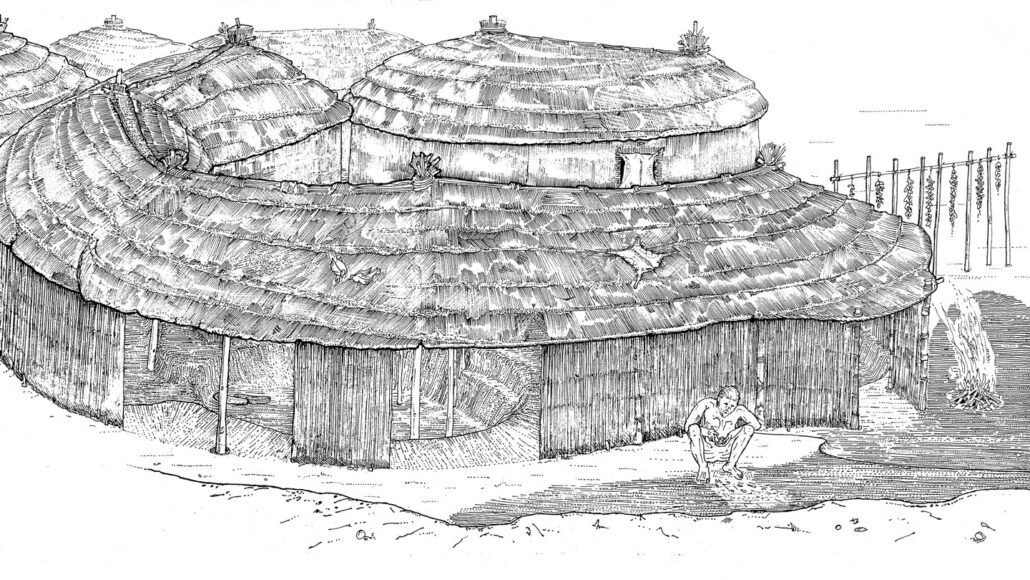What does charred ancient poop reveal about early animal-raising?
Crystals in that dung hint humans may have started tending animals almost 13,000 years ago

Abu Hureyra (illustrated) was an ancient settlement in present-day Syria. Early humans living there burned animal dung as fuel nearly 13,000 years ago — wastes from animals they tended on-site.
Andrew Moore (CC-BY 4.0)
Hunter-gatherers living in southwest Asia may have started keeping and caring for animals nearly 13,000 years ago, new data show. That’s roughly 2,000 years earlier than previously thought.
Ancient plant samples from present-day Syria show hints of charred dung. That reveals that people were burning animal droppings during the Old Stone Age, when all humans were still hunter-gatherers.
The new findings suggest folk there used the dung as fuel. Having access to it suggests these people started tending animals even before they began growing food crops. But much remains unclear. Among those questions: Which animals provided the poop and how did they relate to humans?
“We know today that dung fuel is a valuable resource,” says Alexia Smith. An archaeobotanist, she studies ancient plants. She works at the University of Connecticut in Storrs. “But it hasn’t really been documented prior to the Neolithic.” The Neolithic — or New Stone Age — began some 12,000 years ago. During that time, people began raising crops. Some also were known to keep domesticated animals.
Smith was part of a team that reexamined 43 plant samples collected in the 1970s from around an ancient home at Abu Hureyra. That archaeological site is now lost, covered by Syria’s Tabqa Dam reservoir. The samples date from roughly 13,300 to 7,800 years ago. That time spans the transition from hunter-gatherer societies to farming and herding ones.
Throughout the samples, the researchers found varying amounts of spherulites (SPHEER-uh-lytes). These tiny crystals form in guts of animals. They’re later shed in dung. Between 12,800 and 12,300 years ago, there was a noticeable uptick in spherulites. And, during that time, darkened spherulites also appeared in a fire pit. That suggests the crystals were heated — likely by burning — to between 500 and 700 degrees Celsius (930 to 1,200 degrees Fahrenheit). Smith’s team shared its discovery September 14 in PLOS One.
Sheep vs gazelles?
“The spherulite evidence reported here confirms that dung of some sort was used as fuel,” says Naomi Miller. Miller works as an archaeobotanist at the University of Pennsylvania. She did not take part in the new analysis.
Smith’s team also looked at earlier published data from the same site. The dung burning they found occurred along with architectural changes reported by others. People in Abu Hureyra began creating straight buildings instead of round ones. That change has been linked to a sedentary lifestyle, more typical of farming groups than hunter-gatherers. Other studies also pointed to higher numbers of wild sheep and fewer small animals for hunting.
Together, these findings suggest that people started tending animals outside their homes, the authors say. At the same time, people making fires from wood and from the dung that piled up.
Identifying the dung droppers could reveal whether those animals were kept outside or in homes. The authors propose the dung came from sheep. They should have been easier to capture than other creatures.
But Miller, who wasn’t involved with the study, isn’t so sure. She suspects roaming wild gazelles were the more likely poop producers. Why? Even if sheep were kept for a few days, they wouldn’t produce very much dung, she notes. Miller finds it easier to imagine them collecting gazelle dung away from home — and then bringing it home to store until the fuel was needed.
“The whole thing is a classic whodunit,” says Melinda Zeder. And perhaps DNA analysis could reveal the dung source. An anthropologist, Zeder studies human societies and culture. She works at the Smithsonian Institution in Washington, D.C., and did not take part in the new study. Gazelle might be the source, she says. If captured young, the animals may have been tended for a time — even if they were never domesticated.
“The interesting thing is that people [were] experimenting with their environment,” she adds. Animal raising could just be a consequence of that experimentation.







